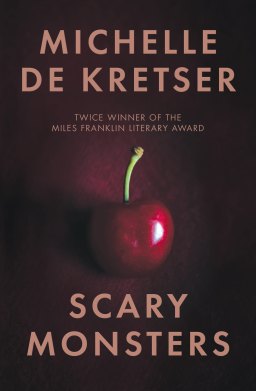This was published 3 years ago
In another masterful work, author Michelle de Kretser has remixed her ingredients
FICTION: Scary Monsters, Michelle de Kretser, Allen & Unwin, $32.99
Which comes first, the cherry or the blossom? That’s one question I contemplated as I turned over Scary Monsters, trying to decide which way to read a novel made up of two parts back to back: Lili’s story bearing a scarlet cherry on its cover, and Lyle’s sprinkled with white blossoms. Take your pick, says the blurb, so in a springtime mood I began with Lyle.
Michelle de Kretser’s recent masterpieces, the Miles Franklin Award winners Questions of Travel and The Life to Come, followed their characters’ lives in more conventional interwoven structures. Sri Lankan-born immigrants to Australia and Australian-born travellers to Europe crossed paths in peripheral and sometimes fateful ways.

Michelle de Kretser’s sleek prose is textured with cultural allusions.Credit: Joy Lai
Scary Monsters has the same DNA but the more radical form separates Lyle and Lili by decades as well as continents. De Kretser makes the reader think about how the two stories might connect. The answer is partly in the repeated references to time, as in Lyle’s words: “Which comes first, the future or the past? Surely the past only reveals itself when we look back at it from now?”
Lyle speaks from an absurd but recognisable future Melbourne, a post-pandemic time when people fear The Next One. Climate change has made cities hot and smoky, surrounded by a Permanent Fire Zone that cannot be named. Islam is banned, dissent of any kind is dangerous, arrests and repatriation are normal.

Credit:
Docile Lyle and his ambitious wife, Chanel, are immigrants from an unnamed country, camouflaged in the “Colgate-white houses” of Spumante Court and embracing the Australian way of life so well that their skins are turning white. He works for the Department, she for the Corporation. The children, Sydney and Mel, rebel in their own privileged ways.
De Kretser is an ever-sharper satirist and here she exaggerates with comic fury. Challenged by the extreme weather and politics of now, she piles on dystopian details. Common tropes are made fresh and funny by her chiselled observations. Lyle’s boss has moved to Melbourne after his Sydney home fell into the harbour and “Woollahra had that super-virulent Aspen strain”. Ouch, that’s my local government area.
Lyle’s deadpan present-tense narration, devoid of irony, shows Australia as a nation of hollow aspiration and “a place free of history”: “Household debt and home improvements are key Australian values. Chanel and I never feel more assimilated than when we wake up with headaches from the smell of paint or when an apprentice plumber is ensuring that our new sink will fail to drain.”
Tension escalates when Lyle’s moral blandness faces corruption and the Amendment, a law that enables “voluntary” euthanasia. Will his rationalisation that killing their old dog was “for Alan’s sake” also apply to his mother, Ivy?
Ivy is the novel’s lynchpin, the subtle link between past and present, old country and new, and the two halves of the book. A passing mention of her cousin, Lilian, is the one clue to how Lyle’s story connects with Lili’s and yet it contains misinformation – the past becomes fiction, fiction becomes memory – as you will learn, or already know if you’ve read that section first.
Lili tells her story as the memory of a time in 1981 when she was 22 years old and living in the south of France. A brown-skinned Asian-Australian, she teaches languages in Montpellier and mixes with a cosmopolitan group of young people, but feels out of place, a disorientated double-migrant.
History is ever-present in France, haunting daily life with the ghosts of totalitarian power and colonialism as well as beauty. Lili reads Simone de Beauvoir’s L’Invitée, aspiring to be a “Bold, Sexy, Modern and Intelligent Woman”. She reads Albert Camus, upset by the murder of the nameless Arab in L’Étranger, but too self-absorbed to understand the hardship of her neighbours. For she is, by comparison, an educated middle-class woman who will leave at the end of summer for Oxford University.
With her artist friend Minna, Lili travels to Sardinia to meet a woman known only as “John Berger’s mistress”. This interlude of mishaps and unplanned meetings (not least with a dog called Gina Lollobrigida) is a gem. Berger, the art critic and author of Ways of Seeing, is another of the novel’s intellectual presences. Though not quoted, he wrote: “The way we see things is affected by what we know or what we believe.”
In a related but more oblique tribute to the style of novelist Shirley Hazzard, de Kretser has her characters crucially misunderstand what they see. And deliciously, she has Lili finish a line of poetry that her friend Nick has forgotten, an echo of the way Hazzard began her friendship with Graham Greene.
This is the other side of de Kretser: the sleek prose textured with cultural allusions, the reflective tone spiced with danger. With the Yorkshire Ripper at large in England, Lili starts to fear her creepy neighbour. Crime-novel noir pervades her mind despite the vivid friendships, political idealism and punk fashions. Scary Monsters is both the David Bowie album they dance to and entrenched human cruelty, a spiked cocktail of nostalgia.
De Kretser invites us to be active participants in completing a narrative structure that might sound gimmicky but succeeds if the reader is as meticulous as the author. I wondered briefly if I should have read the book in the more chronological order but Lyle’s ghastly future loomed as a warning that the monsters of the past still roam our complacent Earth. Each story is a shapely and engrossing if unresolved novella. Together, however you read them, they form a rich, resonant whole.
In yet another masterful work, de Kretser has pulled out her recipe book and remixed her ingredients into a strong, hallucinatory brew that might make us taste fear and anger before it’s too late. If Lili were alive now, in her 60s, she would be shaken up too.
Scary Monsters is published on October 19.
The Booklist is a weekly newsletter for book lovers from books editor Jason Steger. Get it delivered every Friday.